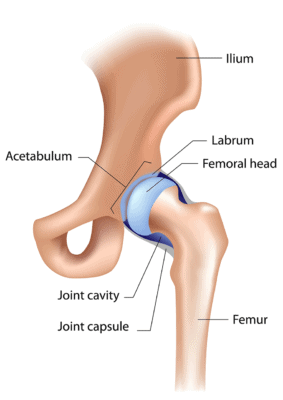Hip Labrum Pain Surgery? A Quartet of New Studies Questions Why We Should Pay Attention to Labral Tears

Alila Medical Media/Shutterstock
I have seen patients enter my office with real fear in their eyes after being told they had a hip labral tear. They seem to associate the words “hip labrum pain” and surgery as if they belonged together like Abbot and Costello. After all, an MRI showed convincing evidence that the hip labrum was torn, shouldn’t this freak anyone out? Turns out that hip labrum tears, like meniscus tears, may not cause any pain.
The last few years has seen an explosive rise in “hip labrum pain surgery”: surgeries to repair labral tears of the hip joint. I’ve been a big critic of jumping to perform aggressive and invasive hip surgeries before we really know more about these tears. First, the labrum is the lip of the hip socket, in fact the term “Labrum” is Latin for “Lip”. The tissue helps to stabilize the hip joint. This labral tissue can become torn, usually with wear and tear. In the last few years, it seems like we have retooled our entire imaging system to now detect and read for these tears that were all but invisible just 5 years ago. So what does the research say about labral tears and pain? Surely, there must be many well done studies showing that labrum tears are the cause of the patients hip pain, hence the surgery? Not so much.
A study just published this month which looked at the MRIs of 85 patients (50 without pain and 35 with painful arthritis) found no association between pain and labral tears. Maybe that’s just an isolated study, right? Nope. A study published earlier this year in professional Dancers showed those with hip pain while dancing had no more evidence of labral tears than women without hip pain. Well, maybe Dancers, who torture their bodies are a special case? Not so much. A study published this past December looked at 45 people with no history of hip pain who were still pretty young (average 38 years old) and found 69% of them had labral tears. OK maybe the problem is that we’re looking at mostly people with no pain, how about if we include patients with pain? A study performed in 2011 did just that, looking at whether 72 patients with hip pain and who later underwent hip arthroscopy had responded to a hip numbing injection. Now if the patient had a painful labral tear, those patients with tears would have responded well to numbing the area. Turns out there was no association between the numbing injections and labral tears. Why did patients get operated on for labral tears when they couldn’t prove that the hip joint was painful with a numbing injection? Your guess is as good as mine.
The upshot? There isn’t much evidence that convincingly shows that labral tears cause hip pain. To us, they are merely evidence that a joint is getting degenerative, not usually a primary focus of our therapeutic attention in most patients. The big question in these patients should be, why is the hip joint getting too much wear force? Some patients do have traumatic labral tears and these in our experience do well with biologic injections (like platelet rich plasma or stem cells) into the tear. Many of these patients never need any surgery.
In summary, for most patients, a labral tear is likely an incidental finding of a hip with wear and tear and not a reason in and of itself to plan surgery. How about surgery then for hip impingement? That’s another story, see link.

NOTE: This blog post provides general information to help the reader better understand regenerative medicine, musculoskeletal health, and related subjects. All content provided in this blog, website, or any linked materials, including text, graphics, images, patient profiles, outcomes, and information, are not intended and should not be considered or used as a substitute for medical advice, diagnosis, or treatment. Please always consult with a professional and certified healthcare provider to discuss if a treatment is right for you.
